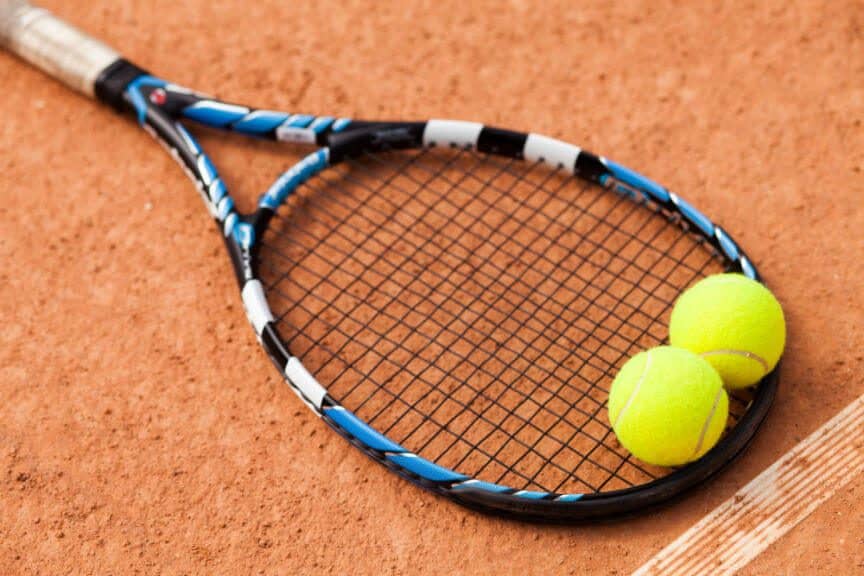Sizing a tennis racket correctly is one of the most important aspects of racket selection. It doesn’t matter how good or expensive a racket is, if the sizing of the racket is off, it will affect your game in a negative way.
Arguably the most critical factor when sizing a racket is getting the grip size right. If the grip is too small, it will result in poor racket stability. If the grip size is too large, it could potentially slip out of your hand. In addition to grip size, other aspects to consider are the racket length, the head size, the cross-section of the racket frame and the balance of the racket: head-light vs head-heavy.
What size tennis racket you should get depends on all of these variables. There is no one size fits all for tennis rackets. Manufactures specifically vary the specs of rackets to appeal to specific types of players. You need to take each of these variables into consideration to determine what fits your style.
While the balance, cross-section, and head size of a racket tends to be more of a personal preference than the grip size, they can have an impact on your play. Let’s take a closer look at each of these technical aspects and how they can affect your selection.
Grip Size
This is the most important aspect of racket selection. You need to make sure the grip size fits your hand properly. Typical adult grip sizes range from 4 1/8″ to 4 5/8″ with 4 3/8″ being the most popular size.
You can test a grip by holding the handle in a continental grip and placing the index finger of your other hand in between your palm and ring finger. The index finger should fit slightly snug in between. If it is too tight the grip is too small. If it is loose, then the grip size is too large.
If you are in-between sizes, opt for the smaller grip size. The reason for this is that you can apply an overgrip on the handle. Most players use overgrips on their handle to improve gripping and absorb some shock.
Another way of measuring grip size is the ruler method. Place a ruler on the second horizontal crease from the top of your palm and measure to the tip of your ring finger. This should give you a fairly accurate number to go by.
If you are unsure where to start or don’t have a racket available to test your grip size, here is a chart that should provide a good starting point based on your height.
Height to Grip Size Chart
Under 5’-0” = 4
5′-0″ to 5’-2” = 4 1/8
5’-3” to 5’-5” = 4 1/4
5’-6” to 5’-8” = 4 3/8
5’-9” to 5’-11” = 4 1/2
6’-0″ to 6′-2″ = 4 5/8
6′-3″ and Up = 4 3/4
Kids’ rackets sometimes come in a smaller grip size, typically 3 7/8″. This size should work well for most children, though a 4″ handle can also be used if the smaller size is not available.
Racket Length
Standard adult tennis rackets are 27″ in length. This length provides a good balance between mobility and stability. If a racket is shorter than 27 inches, it will offer greater speed but less stability. This type of racket may work for smaller kids or beginners since it’s easier to swing the racket.
If it is greater than 27 inches, it will provide more power but also be heavier in weight (less mobility). More advanced players sometimes opt for a longer and therefore heavier racket that can provide added power. Keep in mind that racket length is only one aspect of power.
Junior rackets for kids tend to be shorter in length. Depending on the age of the child, lengths can range from 19″ for children 5 and under, to 26″ for kids age 11 and above. Below is a general guide for racket length by age.
Recommended Racket Length by Age
Under 5 years old: 19″ racket length
6-8 years old: 21″ to 23″ racket length
9-10 years old: 25″ racket length
11 and above: 26″ racket length
Cross Section
Cross-section affects how flexible a racket is. If the cross-section of a frame is thick, it will tend to be stiffer as well. The large cross-section decreases the ability of the racket to flex, resulting in a stiffer feel.
A thinner cross-section will allow the tennis racket to flex more, so the racket will feel less stiff. Rackets that are more flexible will absorb shock better and be easier on the arm. People with elbow or shoulder problems will benefit from more flexible frames.
On the other hand, those seeking greater power on their shots would likely want to opt for a stiffer frame. Stiffer frames tend to transfer more shock to the arm, something to consider if you have issues with your elbows, shoulders, or wrists.
Cross-section width is measured in millimeters. Rackets that are more flexible will have beam widths of 22mm or less. Rackets that are more power-oriented will typically have beam widths of 28mm or more. A more balanced racket will have a cross-section that is somewhere in between.
In combination with the cross-section, another number to look for is the stiffness index. Stiffness is measured on a scale from 0-100, with most rackets falling in the 45 to 75 range. Rackets that are more flexible will have a stiffness rating in the lower range, while more stiff rackets will approach the higher range.
Racket Head Size
Racket head size is measured in square inches. It is an important factor in determining the power of a racket. This is due to the trampoline effect that results from the length of the strings. Larger head sizes will have longer strings (more power, less control), smaller head sizes shorter strings (less power, more control).
In addition to power, larger racket head sizes also provide greater stability since they reduce torque on shots hit outside the sweet spot. Smaller head sizes have a smaller sweet spot but are more nimble. Players who like to generate their own power and want greater control tend to prefer smaller head sizes.
Typical racket head sizes range from 85 to 118 square inches. Mid-size rackets fall in the 85-94 square inch range, mid-size plus range from 95-105 square inches and oversize rackets range from 106-118 square inches.
When considering the head size, take into account what you want out of a racket. If you opt for an oversize head for greater power, this will affect your feel and ability to place the ball. Smaller size frames, on the other hand, offer a smaller sweet spot, so they tend to be less stable.
Racket Weight
Rackets that weigh 11 ounces and up are considered heavy and will tend to provide a heavier swing weight but will also offer less maneuverability. Heavier rackets will generate more power, but because they are more difficult to maneuver they will also be slower.
Rackets that are 10 ounces or less are considered light rackets and will have greater maneuverability but less stability. Rackets that are in between 10 and 11 ounces offer a balance of these features. Lighter rackets offer more speed allowing you to more easily maneuver your strokes, but at the cost of stability.
Balance: Head-Heavy vs Head-Light
In addition to overall weight, rackets are also balanced so that they are either head-heavy or head-light. This is something else you need to take into account when picking out a racket.
Head-heavy rackets increase stability and momentum. They will feel more solid when striking the ball and generate more power. However, they will be more difficult to maneuver and generally be slower.
Head-light rackets, on the other hand, provide greater maneuverability. They are easier to swing and adjust direction, but on the other hand, they will feel less stable. When making contact with the ball, the racket will tend to vibrate or even shift if not hit on the sweet spot.
Balance is typically expressed in points. A racket will be a specific number of points head-light or head-heavy. The higher the number, the more extreme the weighting one way or the other.
String Pattern
String pattern is more about spacing than sizing per se, but it also plays an important role in how a racket plays. The tighter the string pattern, the more control the racket bed will provide. On the other hand the more spaced the string pattern, the more spin and trampoline effect the racket will provide.
A dense pattern is 18×20 while an open pattern is 16×19 or less. The numbers refer to the number of horizontal and vertical strings on the racket head. When selecting between one and the other, ask yourself if you are looking for more control or if you favor spin and power over control.
Keep in mind as well that open string patterns tend to be less durable. The denser the string pattern, the more the strings will last since they are subjected to less friction and movement.
Final Notes
As you can see, aside from grip size and racket length in the case of junior players, most other variables are a personal preference. If you are unsure of what specs to go with, you might want to opt for a mid-size plus frame since they provide greater stability and are more forgiving on shots hit outside the sweet spot.
Mid-size plus rackets are gaining in popularity among both beginners and advanced players because they offer a large sweet spot and plenty of power, without sacrificing control and feel to the extent that oversize rackets do.
If comfort is important to you, opt for a racket that is less stiff and has a smaller beam cross-section. Younger players may want to opt for lighter rackets or rackets that are head-light for better maneuverability.
Players that have long strokes and tend to overhit might want to experiment with a control racket, one with a smaller head size, narrower frame cross-section, and lower stiffness rating (more flexible).
Finally, if at all possible, it’s always a good idea to demo a few rackets before making a purchase. Most tennis stores will offer demo programs so that you can try out 3 or so rackets at a time. This will help you narrow down your choices to rackets that fit your particular style of play.
If you’d like to read more on tennis racket features and see the rackets I recommended for beginners or advanced players, visit the recommended rackets page for more information.
Share this Post

